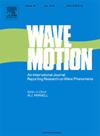High-Order B-spline approximation for solving time-dependent Timoshenko vibrating equations
IF 2.5
3区 物理与天体物理
Q2 ACOUSTICS
引用次数: 0
Abstract
The aim of this work is to study the time-dependent coupled Timoshenko partial differential equations (PDEs) with mixed boundary conditions. These wave equations govern the beam displacements in the fields of structural mechanics and civil engineering. The modeling algorithm is implemented in two steps: Firstly, we transform the time-dependent coupled equations into coupled transverse vibrating equations depending on the frequency parameter and space variable. A Galerkin approximation built on Normalized Uniform Polynomial Spline (NUPS) basis functions is employed to compute the pairs of solutions that are the focus of this work. Secondly, we compute the Inverse Fourier Transform (IFT) solution using some quadrature. We also exhibit comparison results for the various calculations of IFT-integral solutions. The theoretical estimates are verified by several tests of Timoshenko wave equations with known analytical solutions. Numerous numerical experiments are presented to validate the numerical convergence rates, and a few examples are also included to demonstrate the high precision, the efficiency, and the outstanding resolution capabilities for both smooth and discontinuous solutions, as well as plots of the 3D beam’s field displacements.
求解时变Timoshenko振动方程的高阶b样条近似
本文的目的是研究具有混合边界条件的时变耦合Timoshenko偏微分方程。这些波动方程在结构力学和土木工程领域中控制着梁的位移。建模算法分两步实现:首先,根据频率参数和空间变量将时变耦合方程转化为横向振动耦合方程;采用基于归一化均匀多项式样条(NUPS)基函数的伽辽金近似来计算本研究的重点解对。其次,利用正交法计算傅里叶反变换(IFT)解。我们还展示了各种计算的ift积分解的比较结果。理论估计通过若干具有已知解析解的Timoshenko波动方程的试验得到验证。通过大量的数值实验验证了该方法的数值收敛速度,并通过一些实例证明了该方法的高精度、高效率和出色的光滑解和不连续解以及三维梁场位移图的分辨率。
本文章由计算机程序翻译,如有差异,请以英文原文为准。
求助全文
约1分钟内获得全文
求助全文
来源期刊

Wave Motion
物理-力学
CiteScore
4.10
自引率
8.30%
发文量
118
审稿时长
3 months
期刊介绍:
Wave Motion is devoted to the cross fertilization of ideas, and to stimulating interaction between workers in various research areas in which wave propagation phenomena play a dominant role. The description and analysis of wave propagation phenomena provides a unifying thread connecting diverse areas of engineering and the physical sciences such as acoustics, optics, geophysics, seismology, electromagnetic theory, solid and fluid mechanics.
The journal publishes papers on analytical, numerical and experimental methods. Papers that address fundamentally new topics in wave phenomena or develop wave propagation methods for solving direct and inverse problems are of interest to the journal.
 求助内容:
求助内容: 应助结果提醒方式:
应助结果提醒方式:


